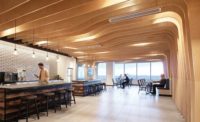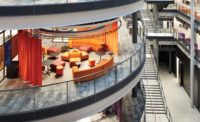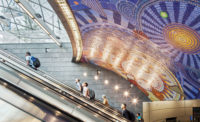Humans are visual creatures, and architects are particularly visual humans—first the drawings and then the photographs are often mistaken for a building’s whole story. But the experience of architecture is more powerful and subtle than eyes alone perceive. Especially in community gathering places, acoustics play a vital role in shaping a building’s character and the quality of experience it facilitates. From theater to library to ashram, designers are working with acoustics to bring their projects into the round.
Few buildings are designed for acoustics more deliberately than performance spaces, as Chicago-based Studio Gang’s new Writers Theatre illustrates. The 36,000-square-foot building comprises two performance spaces (a main stage and a smaller black-box venue) opening onto a glass lobby structured by timber trusses. Located in Glencoe, Illinois, and completed in 2016, the new theater replaces a much smaller-capacity venue in which Writers grew up. Theatrical intimacy has characterized the spoken-word company since its start in 1992, and the design team strove to maintain that quality even as Nichols Theatre, Writers’ new 250-seat main stage, more than doubled the capacity of the previous venue and quadrupled its acoustic volume.
The spatial design fosters intimacy using a thrust stage around which the audience is seated, with no edge or change of level to separate the front row from the performance. But the acoustics for Writers’ typically unamplified performances presented a complex challenge in the larger room. The human auditory system measures the volume of a space by subconsciously comparing the difference between the time direct sound arrives along the line of sight and the time reflected sound arrives from the space’s perimeter surfaces. The farther away these surfaces are from the listener, the later their reflections arrive; the later the reflections, the more degraded the sense of acoustic intimacy. “In acoustic terms, a fourfold increase is vast,” says Carl Giegold, a partner with Threshold Acoustics, Chicago-based consultants to the project.
Threshold uses the metaphor of storytelling around a forest campfire to describe its solution for creating the feeling of being close to or alone with performers, even with more distant surfaces. The actors onstage represent the light, heat, and story around which the audience gathers; unlike the walls of a room, the boundary of a forest clearing—tree trunks and canopy—is diffuse and vague. Translating this experience into built form, the design surrounds the audience with a diffusive screen. Bricks salvaged from the facade of Writers’ previous home (a 1938 structure demolished to make way for the new building) are offset 8 inches from the primary theater’s perimeter walls. They form a highly articulated surface that changes in shape and amplitude as it rises from floor to catwalk. “The complex patterning of the screen mimics the randomness of the outdoor environment,” says Giegold, “and defeats the acoustic boundaries of the room.”
Importantly, the brick screen does not absorb the sound; instead, it breaks sound waves into random energy. “We kept that energy in the room,” says Giegold. “We diffused it and sent it back to envelop the audience in an ambience rather than in a series of hard reflections.” While the sound continues to infuse the theater with energy, it no longer betrays its size.
Having dealt with undesirable reflections from distant surfaces, the designers then set about further enhancing intimacy by introducing a few deliberately distinct reflections from spots near the actors. Small but critically placed and shaped reflectors are located on the underside of the catwalks, and a couple of sail-like reflectors are suspended between them. These take the sound on stage and throw it across the room, so that an actor speaking with his or her back to one side of the audience is nonetheless intelligible. “We end up with a distinctive, intimate character that is the hallmark aesthetic of Writers Theatre,” says Juliane Wolf, a design principal at Studio Gang.
While a theater needs as blank an acoustic slate as possible, libraries’ acoustic needs are increasingly various. The Old Galt Post Office Idea Exchange in Cambridge, Ontario, by Toronto-based RDHA, and the new Central Library in Austin, Texas, by San Antonio– based Lake|Flato and Boston-based Shepley Bulfinch, represent a new breed of library: they are intended as dynamic, polyvalent gathering places. With spaces that can accommodate diverse programming, they address more challenging acoustic issues than libraries have historically faced.
Dubbed Canada’s first bookless library, the Galt Idea Exchange, scheduled to open in spring 2018, engages creative people of all ages. The project renovates a 9,000-square-foot heritage post office, adding a new transparent pavilion that doubles the post office’s floor area and cantilevers 20 feet over the Grand River. The lower level offers a black-box theater and multipurpose room, audiovisual recording suites, and studios for playing musical instruments on loan. An atrium connects to the main level, which includes a periodicals reading room, café, and restaurant. Upstairs, the Children’s Discovery Centre and the adult Creation Space offer opportunities ranging from robotics and 3-D printing to woodworking and sewing. Part of a municipal library system, the Idea Exchange complements an existing book-based library in the community.
Similarly, the Austin Central Library, a 200,000-square-foot facility that opened in October, celebrates books and reading. Jonathan Smith, an associate partner at Lake|Flato, calls it the best daylit library in America, due in large part to a six-story atrium that includes extensive skylights, clerestories optimized for their solar orientations, and a generous east-facing curtain wall. The facility also extends its capacity for community engagement with a 250-seat event space, meeting rooms, art gallery, café, screened porches for reading overlooking Lady Bird Lake, and a rooftop garden, as well as dedicated multiuse areas for children and teens.
“The goal for any community space is to provide a comfortable acoustic environment for multiple applications,” says Payam Ashtiani, a principal with Mississauga, Ontario–based Aercoustics Engineering, consultants to the Galt Idea Exchange. To achieve that goal, the acoustic design must address three primary factors: room acoustics (the behavior of sound in the space), sound isolation (the exclusion of noise from outside the space), and mechanical-noise control (the control of sound from building services). Ken Dickensheets, principal of Austin-based Dickensheets Design Associates, acousticians for the Austin Library, concurs. He adds that acoustic analysis early in the design process maximizes the opportunities for cost-effective solutions.
The distribution of program elements, for example, can simplify acoustics by locating zones that require quiet away from sources of noise, including mechanical equipment. The Austin Library’s event space is on the lower level for this reason, as are the Galt Idea Exchange’s performance and recording spaces.
Once the opportunities for passive solutions have been fully taken advantage of, floors and walls can be designed to further isolate spaces. An assembly’s Sound Transmission Class (STC) rating describes its ability to attenuate the transmission of sound in the audible frequency range. In general, good acoustic separation between adjacent spaces can be provided with demising partitions that have an STC rating of 45 to 50.
At the Idea Exchange, STC-50 is achieved for multipurpose-room walls with two layers of ⅝-inch gypsum board on either side of 3⅛- inch, fiberglass-insulation-filled steel studs. For the recording suite, which requires a higher STC rating, the insulated studs are doubled on either side of a 2-inch air gap. To prevent sound flanking (the transmission of sound around, over, or under the primary partition separating two spaces), the suite’s concrete floor slab is isolated from the structure with neoprene gaskets.
Within a room, reverberation time (RT) is defined as the interval in which sound decays by 60 decibels (dB). (Decibels are the logarithmic unit used to measure the intensity of sound.) To prevent collaborative spaces’ becoming too noisy, the target RT for the Idea Exchange’s Creation Space was less than one second, with a low of 0.6 seconds for the recording studios. For the atrium, an RT of 1.2 to 1.5 seconds maintains the feeling of a large, open space without allowing noise to build to a din.
The Idea Exchange primarily uses perforated acoustic drywall to achieve the desired Noise Reduction Coefficients (NRCs). The material meets a budget that Tyler Sharp, principal at RDHA, describes as difficult, given the ambitions of the project. But it also has desired aesthetic qualities, says Sharp. Its continuous, uniform dot pattern flows evenly across the atrium ceiling’s angular geometry, and the dots relate neatly to the pattern of the curtain wall’s ceramic frit.
To achieve the NRC required for its atrium, the Austin Library uses acoustical plaster on the ceiling and undersides of projecting floor slabs. A relatively expensive material that shows abuse, acoustical plaster suits these out-of-the-way applications. Two large, south-facing walls designed to reflect daylight into the library are clad with perforated metal panels backed with acoustical batts to prevent them from also reflecting sound. “The fact that this giant volume isn’t echoey makes the building feel more approachable,” says Smith. “It doesn’t show in the photos, but when you’re there, you have a great feeling in the space.”
If acoustic tranquility is welcome even in the new, more dynamic breed of library, it is a necessity in the Temple of Light, a sanctuary and meeting place for the Yasodhara Ashram, a yoga retreat and study center in the mountains of southeastern British Columbia. The new temple, designed by Vancouver-based Patkau Architects and completed this summer, replaces an earlier one destroyed by fire.
The temple responds to the collective memory of the original space (which comprised eight rotationally symmetric bays, like its replacement). But it also takes cues from the spectacular clifftop site, with its views of Kootenay Lake and the surrounding forest, and from the lotus flower, an important symbol in the yogic tradition, says Luke Stern, manager of design research at Patkau.
Constructed of prefabricated wood panels’ acting in concert with glulam arches and shear wall elements, creating an integral shell, the temple is the focal point of the spiritual life of the ashram. The form of the primary volume, pinwheel in plan, is made up of eight interlocking petals, curvilinear yet built of straight members, and radiating from a central oculus.
Because of the project’s modest budget of $2.75 million, the design team could afford only a simplified approach to acoustic modeling. The acoustic consultants, Vancouver-based RWDI, offered advice based on the sound quality of a simple dome, without the compound curves of the eight petals, in which the RT would reach 3.5 seconds or longer. (An echoey gymnasium has an RT of about 2 seconds.) The architects knew that the design’s curves would mitigate the long RT but considered additional measures to be in order.
The temple’s unusual geometry was designed in part to mitigate the focusing issues that afflict simple domes. There are no parallel surfaces that would cause significant harmonic resonances or flutters, says Stern, and where concave surfaces occur, they are not centrally focusing, so that acoustic hot spots from each of the eight petals don’t overlap. Moreover, those hot spots mainly occur above head height.
At the base of the petals, which are finished in white-painted gypsum board, glazing provides views of the temple’s lakeside setting. To prevent sound’s ricocheting off the hard surface of the glass and back to the building’s occupants, the architects segmented and angled the glass to direct reflections upward, beyond head height. And to absorb excess acoustic energy, a pinwheel array of 96 melamine-foam baffles is suspended from the oculus at the top of the dome. The overall envelope of this acoustic chandelier supports the temple’s floral metaphor, as if they were the anthers and filaments of stamens.
Since the building opened, it has hosted musical performances as well as meditation, yoga practice, and instruction. “The acoustics have far exceeded expectations,” says Stern.
In common with the designers of Writers Theatre, the Old Galt Post Office, and the Austin Library, Stern describes acoustics as an oftenneglected aspect of architectural design. “They really can negatively affect people’s experience of a space, no matter how wonderful it is formally,” he says. Conversely—as these projects illustrate—when acoustics are taken as a significant design parameter from the start, they enrich the multisensory experience that is architecture.
|
Continuing Education
 To earn one AIA learning unit (LU), including one hour of health, safety, and welfare (HSW) credit, read the "Continuing Education: Acoustics," review the supplemental material listed below, and complete the online test. Upon passing the test, you will receive a certificate of completion, and your credit will be automatically reported to the AIA. Additional information regarding credit-reporting and continuing-education requirements can be found online at continuingeducation.bnpmedia.com. To earn one AIA learning unit (LU), including one hour of health, safety, and welfare (HSW) credit, read the "Continuing Education: Acoustics," review the supplemental material listed below, and complete the online test. Upon passing the test, you will receive a certificate of completion, and your credit will be automatically reported to the AIA. Additional information regarding credit-reporting and continuing-education requirements can be found online at continuingeducation.bnpmedia.com.Supplemental Material
Learning Objectives 1 Describe acoustical strategies for making a large space feel intimate. 2 Describe strategies for optimizing acoustics in spaces intended for diverse uses. 3 Describe acoustical strategies for mitigating mechanical noise and noise from outside a space. 4 Define such terms as reverberation time, sound-transmission class, and noise-reduction coefficient.
AIA/CES Course #K1712A
For CEU credit, read "Continuing Education: Acoustics" and take the quiz at continuingeducation.bnpmedia.com, or use our Architectural Record Continuing Education app, available in the iTunes store. structure, finishes, and other original fabric when
a building is moved.
significant buildings.
|













Post a comment to this article
Report Abusive Comment